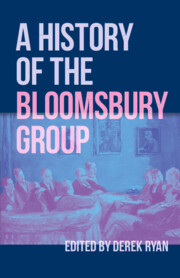
-
Select format
-
- Publisher:
- Cambridge University Press
- Publication date:
- October 2025
- October 2025
- ISBN:
- 9781009423632
- 9781009423663
- Dimensions:
- (229 x 152 mm)
- Weight & Pages:
- 0.5kg, 456 Pages
- Dimensions:
- Weight & Pages:
You may already have access via personal or institutional login
Book description
A History of the Bloomsbury Group ranges more widely across the Bloomsbury group's interdisciplinary activities and international networks than any previous volume. From innovations in the literary and visual arts to interventions in politics and economic policy, core members including Virginia Woolf, Leonard Woolf, E. M. Forster, Lytton Strachey, Vanessa Bell, Clive Bell, Duncan Grant, Roger Fry, and John Maynard Keynes are explored in relation to a diverse cast of lesser-studied figures to offer an expansive and multifaceted account of the group's achievements and influence. Leading international scholars provide authoritative and accessible commentaries on a variety of topics under the broad headings of 'Aesthetic Bloomsbury,' 'Global Bloomsbury,' 'Intimate Bloomsbury,' and 'Public Bloomsbury.' Whether addressing established narratives or pushing into new critical terrain, the book demonstrates that, more than a century on from its formation, the Bloomsbury group remains an active and dynamic force in the key critical debates of today.
Contents
Metrics
Altmetric attention score
Full text views
Full text views help Loading metrics...
Loading metrics...
* Views captured on Cambridge Core between #date#. This data will be updated every 24 hours.
Usage data cannot currently be displayed.
Accessibility standard: WCAG 2.0 A
Why this information is here
This section outlines the accessibility features of this content - including support for screen readers, full keyboard navigation and high-contrast display options. This may not be relevant for you.
Accessibility Information
The PDF of this book conforms to version 2.0 of the Web Content Accessibility Guidelines (WCAG), ensuring core accessibility principles are addressed and meets the basic (A) level of WCAG compliance, addressing essential accessibility barriers.
Content Navigation
Table of contents navigation
Allows you to navigate directly to chapters, sections, or non‐text items through a linked table of contents, reducing the need for extensive scrolling.
Index navigation
Provides an interactive index, letting you go straight to where a term or subject appears in the text without manual searching.
Reading Order and Textual Equivalents
Single logical reading order
You will encounter all content (including footnotes, captions, etc.) in a clear, sequential flow, making it easier to follow with assistive tools like screen readers.
Short alternative textual descriptions
You get concise descriptions (for images, charts, or media clips), ensuring you do not miss crucial information when visual or audio elements are not accessible.
Structural and Technical Features
ARIA roles provided
You gain clarity from ARIA (Accessible Rich Internet Applications) roles and attributes, as they help assistive technologies interpret how each part of the content functions.

